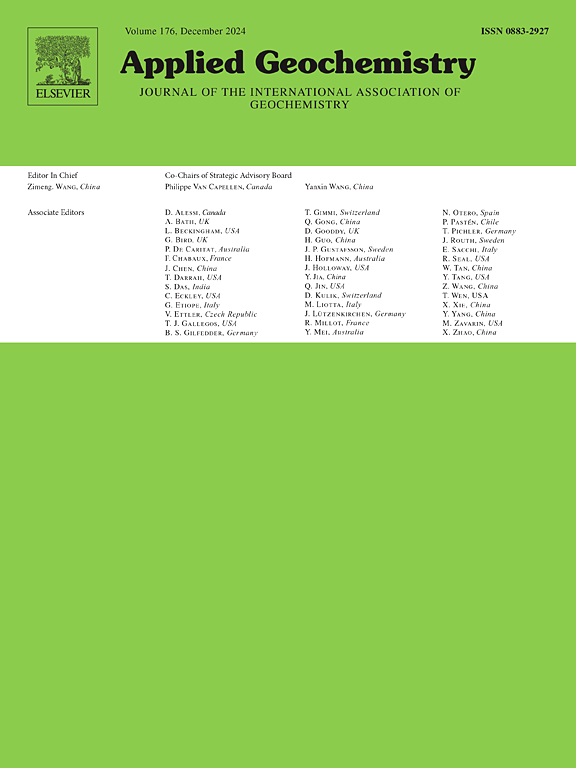在Ca-Sr阳离子和OH-F阴离子亚晶格位置双共取代的磷灰石固溶体系中的水溶性
IF 3.1
3区 地球科学
Q1 GEOCHEMISTRY & GEOPHYSICS
引用次数: 0
摘要
为了研究污染土壤和含水层中磷灰石相对Sr-90放射性核素的吸附潜力,研究了磷灰石超基团体系(Ca,Sr)5(PO4)3(OH,F)中固溶体的溶解度乘积常数。在200℃下水热合成了不同组成的羟基和氟磷灰石二元固溶体,并用Rietveld和化学分析对其进行了表征。随着Sr含量的增加,晶格轴长和胞体体积呈线性增加,符合Vegard定律,表明固溶体系中存在混合现象,且没有混合间隙。溶解研究在25°C下通过水批平衡实验进行。水溶液溶解度随着sr的摩尔分数的增加而增加。然而,经过数周的批量平衡导致了化学计量而不是真正的平衡状态。这种固溶体的化学计量溶解通常在诸如磷灰石矿物之类的低溶解度相中观察到。固溶体的化学计量饱和对应于固相和水相的等摩尔吉布斯能量函数,可以用李普曼图中的“等g曲线”(EGC)表示。化学计量溶解度积常数Kst由溶解实验中溶质活度计算得到。这些常数沿着连接端元溶解度乘积常数的EGC直线排列。因此,固相中过量的吉布斯混合能为零,表明形成了理想的固溶体体系。首次成功绘制了用大于1的化学计量因子取代阳离子的正确二元李普曼相图。这些图允许预测任何固溶体组成的溶解度,包括阳离子和阴离子亚晶格中的共取代,这是第一次用四元李普曼图来表示。结果表明,在短期亚稳(化学计量)溶解度条件下,Sr取代Ca增加了所得固溶体的溶解度,并可能导致长期热力学平衡条件下Sr的优先释放。这些发现为利用磷灰石型矿物固定Sr-90放射性核素提供了重要的环境意义。本文章由计算机程序翻译,如有差异,请以英文原文为准。

Aqueous solubilities in the apatite solid-solution system with double co-substitution on both Ca–Sr cation and OH–F anion sublattice positions
To investigate the potential for Sr-90 radionuclide sequestration by apatite phases in contaminated soils and aquifers, the solubility product constants of solid solutions in the apatite supergroup system (Ca,Sr)5(PO4)3(OH,F) were studied. Binary hydroxyl- and fluorapatite solid solutions of varying compositions were synthesized hydrothermally at 200 °C and characterized by using Rietveld and chemical analysis. The lattice axis lengths and cell volumes exhibited a linear increase with increasing Sr content, adhering to Vegard's law and indicating mixing without mixing gaps in the solid-solution system. Dissolution studies were conducted at 25 °C through aqueous batch equilibrium experiments. Aqueous solubility increased with the mole fraction of Sr. However, batch equilibration over weeks led to a stoichiometric rather than a true equilibrium state. Such stoichiometric dissolution of a solid solution is commonly observed in low-solubility phases such as apatite minerals. Stoichiometric saturation for solid solutions corresponds to equal molar Gibbs energy functions of the solid and aqueous phases, which can be represented by an “equal-G curve” (EGC) in Lippmann diagrams. Stoichiometric solubility product constants Kst were calculated from the solute activities in the dissolution experiments. These constants align along the straight EGC line connecting the endmember solubility product constants. The excess Gibbs energy of mixing in the solid phase is therefore zero indicating formation of an ideal solid solution system. Correct binary Lippmann phase diagrams were successfully plotted for the first time for substituting cations with stoichiometric factors greater than unity. These diagrams allow for the prediction of solubilities across any solid solution composition, including co-substitutions in both the cation and anion sublattices as represented for the first time by a quaternary Lippmann diagram. The results illustrate that substitution of Ca by Sr increases the solubility of the resulting solid solutions under short-term metastable (stoichiometric) solubility conditions and may lead to preferential Sr release under long-term thermodynamic equilibrium conditions. These findings provide significant environmental implications for Sr-90 radionuclide immobilization using apatite-type minerals.
求助全文
通过发布文献求助,成功后即可免费获取论文全文。
去求助
来源期刊

Applied Geochemistry
地学-地球化学与地球物理
CiteScore
6.10
自引率
8.80%
发文量
272
审稿时长
65 days
期刊介绍:
Applied Geochemistry is an international journal devoted to publication of original research papers, rapid research communications and selected review papers in geochemistry and urban geochemistry which have some practical application to an aspect of human endeavour, such as the preservation of the environment, health, waste disposal and the search for resources. Papers on applications of inorganic, organic and isotope geochemistry and geochemical processes are therefore welcome provided they meet the main criterion. Spatial and temporal monitoring case studies are only of interest to our international readership if they present new ideas of broad application.
Topics covered include: (1) Environmental geochemistry (including natural and anthropogenic aspects, and protection and remediation strategies); (2) Hydrogeochemistry (surface and groundwater); (3) Medical (urban) geochemistry; (4) The search for energy resources (in particular unconventional oil and gas or emerging metal resources); (5) Energy exploitation (in particular geothermal energy and CCS); (6) Upgrading of energy and mineral resources where there is a direct geochemical application; and (7) Waste disposal, including nuclear waste disposal.
 求助内容:
求助内容: 应助结果提醒方式:
应助结果提醒方式:


